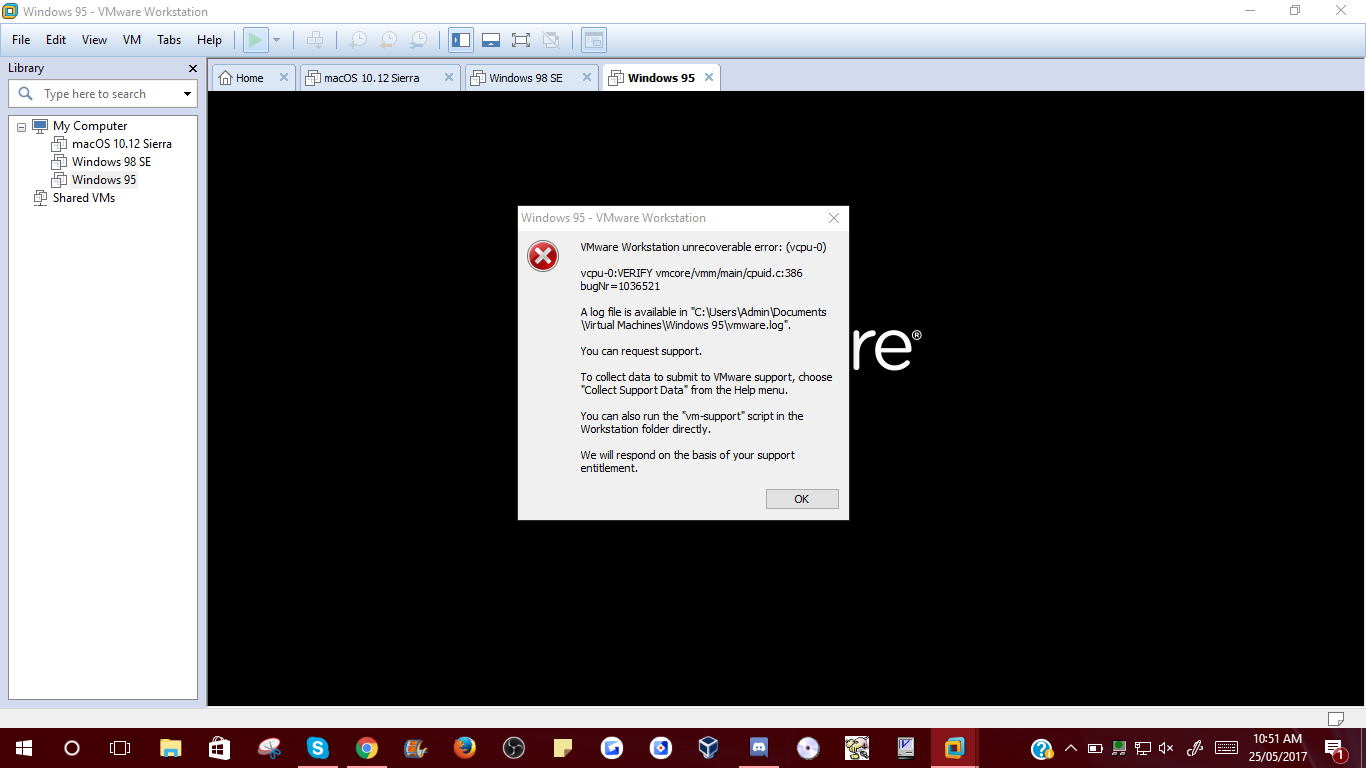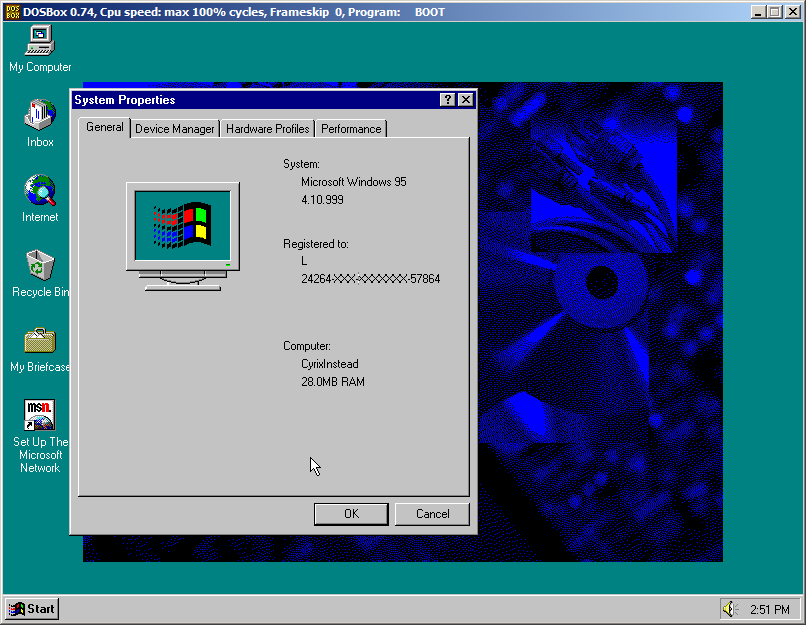Install Windows 95 Using Dosbox
What is mounting?Mounting is a process that makes a storage device (hard disk, CD-rom, CD- or DVD image) accessible within an operating system or within certain software like DOSBox. Automatic mountingIf you use DOSBox a lot, you'll probably want to automate the mounting of the virtual DOSBox drive.
Old guide wrote:You just can't do it while in DOSBox's own DOS shell-you need to boot up from pure DOS.Let me know if you want anything elaborated; I kind of wrote this in a hurry since I've got a ton of other work to get done today and should really be getting started1. Get a boot diskFirst off, get an MS-DOS boot disk. You'll need a.img file. I myself used from.I don't know exactly which versions of MS-DOS will work, but I suppose 7 should be fine too.
I've read that you can cheat Windows into accepting a different version by using set ver 6.0, but I can't confirm this myself since if you use 6.22 you'll never run into this problem.Make sure this file is in your DOSBox directory.2. Make a hard disk imageYou can do this using the bximage program that comes with Bochs.
Contains a built in command for creating these from within DOSBox. (Would be awesome if that could be merged with the main branch.)Making an image using bximage is extremely straightforward.
There's a section on using it too.All you really need to remember when using bximage is the cylinder count, since everything else is standardized and shouldn't be changed. In my example I'm making a 400 MB image which has 812 cylinders.
Only flat images are supported (as of this time of editing). Sparse images will not be recognized. However, it's possible to still compress flat files using your host OS's filesystem; in Windows XP, this is the default behavior (hence the blue filename).Copy this file (let's call it c.img) to your DOSBox directory.3. Mount and format your new hard disk imageSo now we have a hard disk image that we're going to be installing Windows 95 on. The problem is it doesn't have a filesystem yet. This is where our boot disk first comes in.Start up DOSBox and type the following:Code: imgmount 2 c.img -size 512,63,16,812 -t hdd -fs noneNote: you may need to replace c.img with the name you gave your image file, and replace 812 with the cylinder count you used when creating the file using bximage.
It should say Drive number 2 mounted as c.img. You might notice that we're not giving it a drive letter: basically, every drive needs to have a filesystem, which is a sort of file index, before it can be used properly. Without a filesystem (like FAT32, NTFS, HFS+, etc.) a filesystem is just empty, unorganized space that the operating system can recognize but can't really do anything with, so until we fix this problem we can't mount it under C or any other drive letter yet. Modifying filesystems on a drive is called partitioning.Now type the following:Code: boot 622c.imgDOSBox will now boot up from the MS-DOS boot disk.The first thing we'll do is use fdisk to create a filesystem. Run fdisk, choose option 1 (Create DOS partition or Logical DOS Drive), then option 1 (Create Primary DOS Partition). When asked if you want the new partition to comprise the whole hard disk, choose Y. A system restart will be prompted.
Press enter; DOSBox will quit.Now that we have our newly partitioned drive, we need to format it to effectively bring it to a completely empty and consistent state so that we can start putting files on it. To do so, we need to restart DOSBox and boot back into MS-DOS. This time, however, we'll mount our drive differently:Code: imgmount c c.imgAt this point, DOSBox should say 'Drive C is mounted as c.img'. If something is wrong, start this step over. Don't attempt to access the C drive from DOSBox's own DOS shell or you might make it unreadable for pure DOS. Now boot into MS-DOS by using the same command as last time:Code: boot 622c.imgWhen you enter the DOS prompt, format your new C drive by typing:Code: format c:Note: if at this point DOSBox is incorrectly reporting the size of your hard disk, that may be due to either a DOSBox bug or a problem with MS-DOS.
I don't know exactly which one, but I've found that hard disk images with a size of over 512 MB (or a cylinder count of over 1000?) tend to be problematic. They'll work, but you'll only be able to use a portion.4. Copy over setup files and start Windows 95 installationAt this point you should have your Windows 95 disc ready. The version should not matter all that much; I'm using a Dutch OEM version myself, the same one I got with my first Pentium computer about 17 years ago.It doesn't really matter if it's an image or not. The trick here is to copy the installation files over to your newly formatted hard disk and then perform the install from there. (If you don't have an image already, consider making one anyway. Discs degrade over time and will become unreadable, especially if it's already a home made copy to begin with.)The easiest way to do this (to my knowledge, anyway) is to mount the c.img file in your operating system.
Qbix mentioned that mount -o loop dos622.img /mnt should do it on Linux. I'm on Mac OS X myself and can mount it by double clicking on the image file in the Finder. On Windows, I'm not entirely sure if this is possible, but a program like Isobuster should work too. Dominus recommends using which is free.
Make sure you close DOSBox before you move the files.All you need to do is move over the entire WIN95 directory (the one containing all the CAB files) from the CD to your mounted and now formatted image. It should be only about 34 MB in size.
Brett manning mastering mix pdf file. Does mastering the mix by brett manning work? Are you a good singer? I am going to sing a song. Is this singer beautiful? It’s like you should complete Singing Success before you come along with Mastering Mix.I’m thinking about getting Mastering Mix.



Unmount c.img and restart DOSBox. We'll now start the installation.Mount c.img like we did the last time and boot 622c.img.To start the installation, type the following:Code: c:cd win95setup /is(The /is flag will prevent Scandisk from running, which is unnecessary.)Note: if the mouse is not working at this point, exit setup and run mouse.com from the A: drive.Windows 95 will now begin installation. To have Windows start up automatically when starting DOSBox, you could edit your config to contain the following under autoexec:Code: autoexecimgmount c c.imgboot c.imgIn a little while, Windows 95 will be installed. If you find that DOSBox isn't running anymore after a while, that's because Windows setup prompted a restart. Simply restart DOSBox and reboot into your c.img (if you haven't already added the above lines to your autoexec).5.
Caveats and finishing upNote that the best way to run Windows 95 under DOSBox is with machine=svgas3, core=normal and cputype=pentiumslow. I'm actually not sure about core=normal being the best choice (qbix mentioned that the dynamic core is probably as safe to use as the normal core), but it's the oldest and most tested.In the past, core=simple was used to run Windows 95, but these days it does more harm than good.
The simple core emulates less instructions and causes visual glitches today.It's possible to get working using HAL9000's, but it requires compiling your own version or using his Megabuild. I'll update this guide later when I get that working.On Mac OS X, make sure you don't set the screen bit depth to anything over 8-bit (256 colors). 16-bit and 32-bit are broken and causes visual glitches. I've also found that it's MUCH faster in full-screen mode when using the opengl output system.Hardware detection should work just fine, so don't worry about DOSBox locking up.6.
To qbix, Dominus, h-a-l-9000 and the rest of the IRC gang for helping me get this working. Visit #dosbox @ irc.freenode.net. Post here if you're having trouble so I can add fixes to the guide.TODO. Get internet working. Get CD-ROM drive working (is this possible?).
Find out how to easily move win95 dir to disk image on Windows host operating system. Svenne wrote:Nice guide, but I can't get MS-DOS to detect the image file. I'm using a MS-DOS 7.1 boot floppy.
The image file is on 500 mb and 1015 cylinders.What kind of error message are you getting? Does the image mount successfully under the DOSBox prompt but then fail to show up in fdisk (actually, causing fdisk to say 'no fixed disks present')?EDIT: well, this is strange. I just tried doing this myself a couple of times with a 500 MB image of 1015 cylinders, but apparently I can't get fdisk to recognize disk images that were set to 'sparse' or 'growing'. The 'flat' image type works consistently, which is strange considering I do believe my own install is on a sparse image.Anybody know what might cause this?Member Posts: 158 Joined: 2009-4-26 @ 12:09 Location: Rotterdam, The Netherlands.
I am getting a wonky error trying to follow this guide when trying to mount the image, specifically.I have a 512MB image - 1040 cyl. I try using the line:imgmount 2 c c.img -size 523, -fs noneIt returns 'The image must be on a host or local drive.'
Run Windows 95 On Dosbox
I have also tried imgmount 3, imgmount 2 c x:c.img (where x: is the dosbox directory where c.img is located mounted in dosbox), imgmount 2 c c:dosboxc.img, and every other logical combination I can think of.I am using that special build w/ glide, NE2000, and etc. Support by one of the members here. Not the MBL, the other - his name escapes me but starts with a 'G'.Member Posts: 192 Joined: 2010-5-29 @ 18:39. Yushatak wrote:I am getting a wonky error trying to follow this guide when trying to mount the image, specifically.I have a 512MB image - 1040 cyl.
Dosbox Windows 95 Online
I try using the line:imgmount 2 c c.img -size 523, -fs noneIt returns 'The image must be on a host or local drive.' I have also tried imgmount 3, imgmount 2 c x:c.img (where x: is the dosbox directory where c.img is located mounted in dosbox), imgmount 2 c c:dosboxc.img, and every other logical combination I can think of.First of all, your bytes per sector in that command is set to 523, it should be 512. Also, when mounting the image the first time, you're not supposed to specify a drive letter but a device type instead (hence the 2; the c in your command shouldn't be there, it should only be used later after partitioning). You also need to make sure you add the -t hdd part.Try this: imgmount 2 c.img -size 512, -t hdd -fs noneMember Posts: 158 Joined: 2009-4-26 @ 12:09 Location: Rotterdam, The Netherlands.